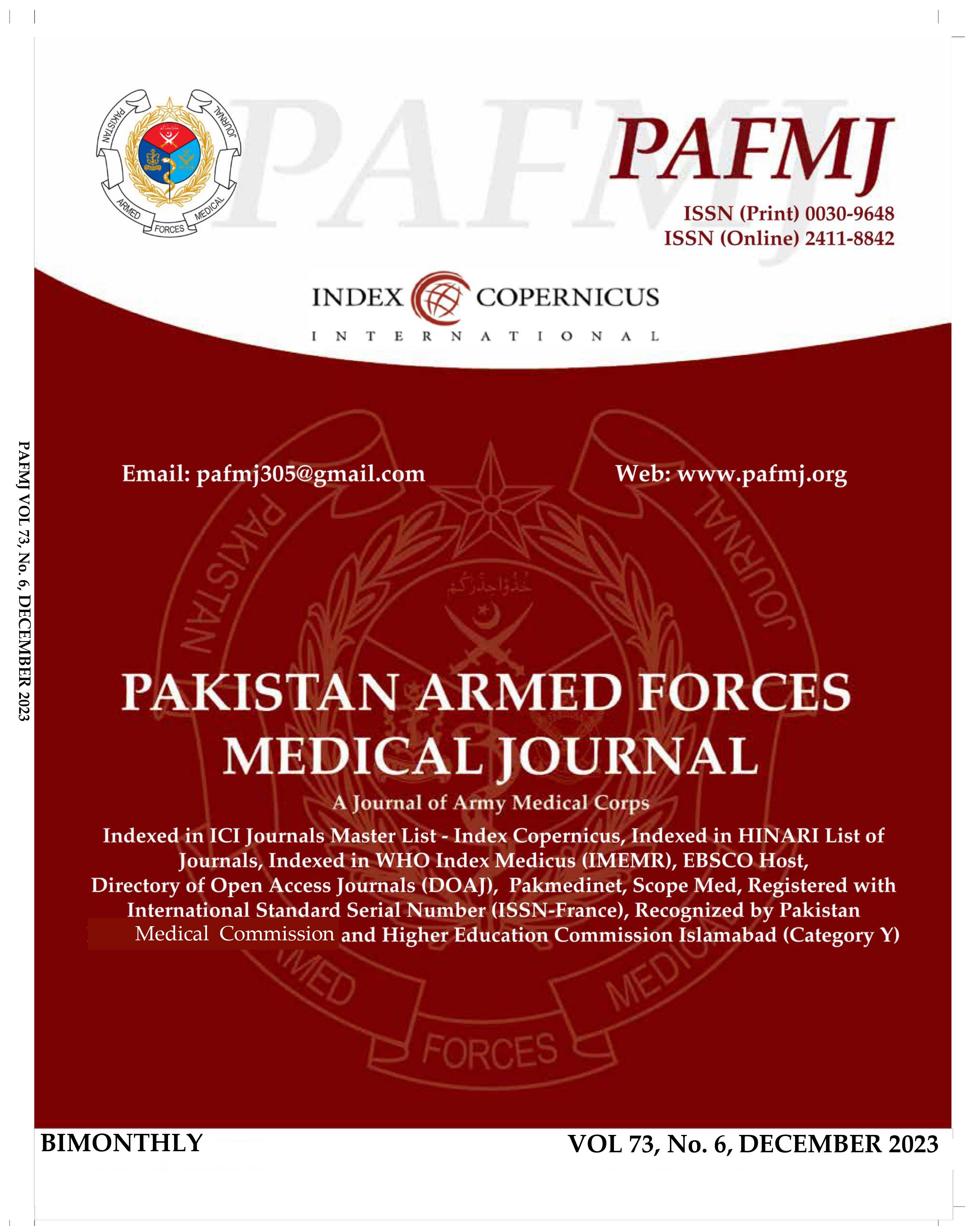Early Triage and Emergency Obstetric Care in High-Risk Pregnancies and Impact on Their Outcome; A Cross-Sectional Study
DOI:
https://doi.org/10.51253/pafmj.v73i6.9131Keywords:
Emergency obstetric care (EmOC), High-risk pregnancy, Intra uterine death, Level III maternal careAbstract
Objective: To assess the role of early triage and emergency obstetric care for high-risk pregnancies and their outcome.
Study Design: Cross-sectional study.
Place and Duration of Study: Combined Military Hospital, Bahawalpur Pakistan, from Jan 2021 to Jun 2022.
Methodology: Women with high-risk pregnancies, aged 18-40 years, gestational age >28 weeks, were included. Emergency obstetric care was provided to participants of the study. Maternal outcome was assessed regarding their hospital stay duration, morbidity, mortality and mode of delivery. The fetal outcome was in terms of intra-uterine death (IUD), Early neonatal death (ENND), and live births.
Results: The mean age of patients was 28.1±3.49 years. Most of the patients belonged to high-order cesarean section and
hypertensive disorders of pregnancy. 94.3% were delivered by cesarean section due to obstetric reasons, and hospital stay was an average of> 72 hours in 57.7 %. Maternal mortality and morbidity were not observed. 99.9% of babies were live births, 0.7% ended into ENND, and one received an IUD.
Conclusion: Early triage followed by the provision of emergency obstetric emergency care is recommended in high-risk
pregnancies for optimum feto-maternal outcome.
Downloads
References
Dutta DC, Text book of Obstetrics. New Central book Agency (P)
Ltd, Calcutta, India; 2015.
https://paramountbooks.com.pk/pro/textbook-of-obstetrics/
Say L, Chou D, Gemmill A, Tunçalp Ö, Moller AB, Daniels J, et
al. Global causes of maternal death: a WHO systematic analysis.
Lancet Glob Health 2014; 2(6): e323-333.
https://doi.org/10.1016/S2214-109X(14)70227-X.
High-Risk Pregnancies and Impact on Their Outcome
Pak Armed Forces Med J 2023; 73(6): 1816
Ameh CA, Mdegela M, White S, van den Broek N. The
effectiveness of training in emergency obstetric care: a systematic
literature review. Health Policy Plan 2019; 34(4): 257-270.
https://doi.org/10.1093/heapol/czz028.
Sajjad R, Ashraf V, Ali CA. Review of Level Iii Maternal Care in
the Patients of Placenta Previa and its Optimal Outcome: OneYear Experience at Combined Military Hospital Lahore. Pak
Armed Forces Med J 2022; 72(1): 105-107.
https://doi.org/10.51253/pafmj.v72i1.3178.
Farajnezhad F, Shaahmadi F, Fashi Z. Prevalence of high risk
pregnancy and some relevant factors in referred women to
health centers. J Sci Achieve 2017; 2(12): 4-7.
Soleimani Z, Danesh A, Basri N, Abaszadeh A, Arab M.
Assessment of high-risk pregnancy in Bam Mahdieh maternity
hospital. Shahrekord Uni Med Sci 2001; 6(2): 67-73
Kulshreshtha S, Babel M. A prospective study of causes and
outcome of high risk pregnancies in referred patients in a tertiary
health care centre of southern Rajasthan. J Obstet Gynecol 2019:
(3); 141-146.
Sun L, Yue H, Sun B, Han L, Tian Z, Qi M, et al; Huai’an PerinatalNeonatal Study Group. Estimation of high risk pregnancy
contributing to perinatal morbidity and mortality from a birth
population-based regional survey in 2010 in China. BMC
Pregnancy Childbirth 2014; 14: 338.
https://doi.org/10.1186/1471-2393-14-338.
Jnaneswari K, Manjubala D. Perinatal outcome in high risk
pregnancies. Int Res J Med Sci 2016; 4(4): 1-4.
Majella MG, Sarveswaran G, Krishnamoorthy Y, Sivaranjini K,
Arikrishnan K, Kumar SG. A longitudinal study on high risk
pregnancy and its outcome among antenatal women attending
rural primary health centre in Puducherry, South India. J Educ
Health Promot 2019; 8(1): 12-14.
https://doi.org/10.4103/jehp.jehp_144_18.
Mehta B, Vijay K, Amamdeep K, Sumit C. Prevalence and
correlates of high risk pregnancy in rural Haryana: A community
based study. Int J Basic Appl Med Sci 2013; 3(2): 212-217
Bari A, Mazhar B . Maternal and perinatal outcomes of high risk
versus low risk pregnancies in tertiary care settings. Rawal
Medical Journal 2012; 37(3): 304-308.
Zareen N, Naqvi S, Majid N, Fatima H. Perinatal outcome in high
risk pregnancies. J Coll Physicians Surg Pak 2009; 19(7): 432-435.
Tahir N, Adil M, Afzal B. Definite management of morbidly
adherent placenta: analysis of maternal outcome. Pak Armed
Forces Med J 2018; 68(5): 1156-1160
Society of Gynecologic Oncology; American College of
Obstetricians and Gynecologists and the Society for Maternal–
Fetal Medicine; Cahill AG, Beigi R, Heine RP, Silver RM, Wax JR.
Placenta Accreta Spectrum. Am J Obstet Gynecol 2018; 219(6):
B2-B16. https://doi.org/10.1016/j.ajog.2018.09.042.
Jadhao AR, Gawade MD, Ughade SN. Outcome of pregnancy
among high risk pregnancies in rural area of Nagpur, Central
India. Int J Commun Med Public Health 2017; 4 (3): 628-633.
Fitzpatrick KE, Sellers S, Spark P, Kurinczuk JJ, Brocklehurst P,
Knight M. Incidence and risk factors for placenta
accreta/increta/percreta in the UK: a national case-control study.
PLoS One 2012; 7(12): e52893.
https://doi.org/10.1371/journal.pone.0052893.
Chaman R, Naieni KH, Golestan B, Yunesian M. Neonatal
mortality risk factors in a rural part of Iran: a nested case-control
study. Iran J Public Health 2009; 38(1): 48-52.















